I want to share a delicious recipe for Chinese-style slow cooker pork hock.
In this recipe, we use the oven to create the perfect blister on the pork skin, which gives it a chewy texture and a satisfying mouthfeel once slow-cooked. Traditionally, it is achieved by deep-frying the pork, but it can be messy and oily. We plan to achieve the same result by roasting the pork at high heat in the oven.
It is a mouth-watering dish prepared with an oven and a slow cooker. I have added the recipe at the end of this article. Meanwhile, let’s start making delicious slow cooker pork hock with Chinese flavors.
Note: This post may contain affiliate links. Please read my privacy policy for more info. I may receive commissions for purchases made through links in this post. As an Amazon Associate, I earn from qualifying purchases.
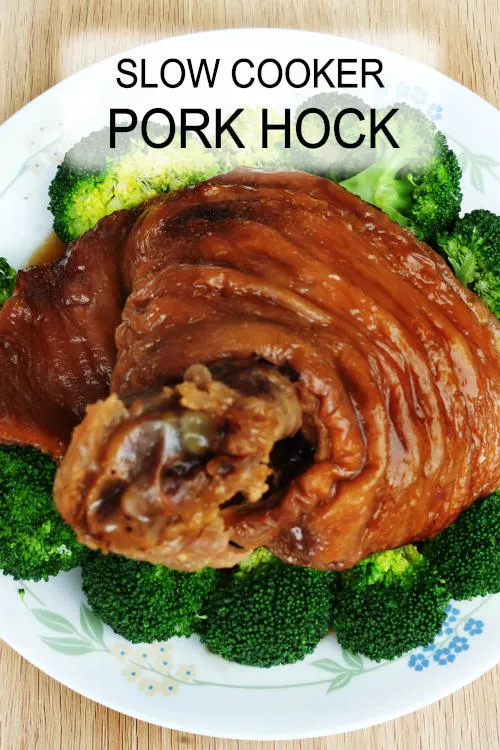
How to slow-cook Chinese pork hock
Blanching the pork hock is a crucial step in the preparation process, effectively removing any unwanted blood smell. Although it may seem simple, this step is essential to ensure a delicious and aromatic dish.
- Begin by thoroughly cleaning the pork hock and changing the water several times until it clears. Please the skin to check for any hairs and remove them either with a kitchen tweezer or by burning them away with a blowtorch.
- Next, place the pork hock in a pot of water to submerge it completely. Then, add a few slices of ginger, two stalks of scallions, and two tablespoons of rice wind, which helps to eliminate any unwanted odors from the pork.
- When the water is boiling, blanch the pork hock over medium heat for ten minutes. Be sure to turn it over at least once for even cooking.
- Once blanched, remove the pork hock and wash it thoroughly under running water. Let it sit for ten minutes to allow any excess water to drain away.
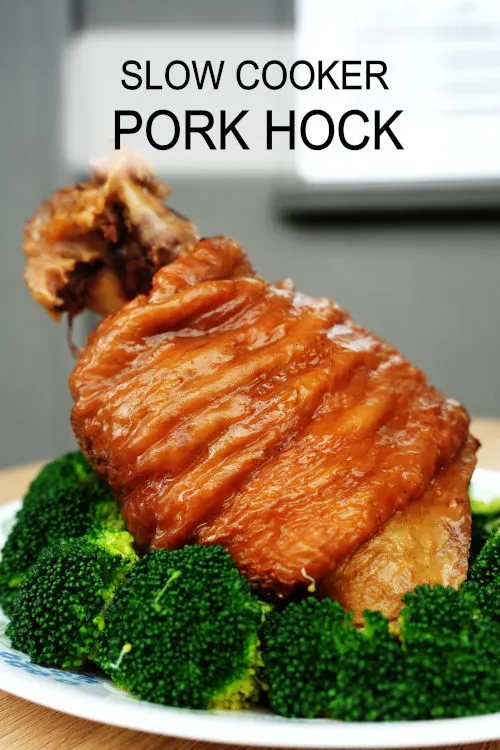
Bake the pork hock to create blisters on the skin
So why make the skin crispy with blisters, then slow-cook it? Isn’t that a waste of effort yo make it crispy?
Chefs use this method to transform the tough texture of pork skin into a slippery, slightly puffy texture that is easy to chew. While the skin may become crispy and blistered after exposure to high heat, it is not the intended final result. The blistered skin will turn into the intended slippery and puffy texture after being slow-cooked. The intended texture cannot be achieved if I skip the intermediate step.
The traditional Chinese method is deep-frying the pork hock using smoking hot oil to create the blister beautifully. I prefer using the oven for a more convenient and tidy way to blister the pork skin. This method minimizes the mess and reduces the risk of hot oil splattering.
I have done the following to make the pork skin blisters:
- Keeping the blanched pork hock in the refrigerator overnight (or at least for half a day) is crucial. This step allows the skin to dry out, which helps to produce crispy skin and create blisters.
- Prepare a mixture of one tablespoon of white vinegar and half a teaspoon of baking soda, then apply to the skin before roasting. The baking soda helps to break down the proteins, promoting crisper and more evenly browned skin. The baking soda will react with the moisture to form carbon dioxide, creating tiny bubbles that increase the skin’s surface area. A larger surface area means it will become more crispy during roasting. Vinegar helps draw out any excess moisture while neutralizing the baking soda.
- Lastly, the pork hock should be roasted at a high temperature of 240°C/465°F to create the desired blisters. By heating at high temperatures, the pork skin undergoes a blistering process that gives it the appearance of being rolled in hot oil.
Here are the steps to make crispy and blistered pork skin in the oven:
- First, remove the pork from the refrigerator. You should wait for it to return to room temperature before roasting it.
- Next, preheat the oven to 245°C/475°F.
- Combine the white vinegar and baking soda, then apply it to the skin surface. This will help make the skin dry and crispy.
- Place the pork skin on the middle rack with the skin side exposed.
- Roast the pork hock for 30-40 minutes or until the skin blistered. Be careful not to burn the pork.
- Finally, remove it from the oven. Let it cool before proceeding to the next step.
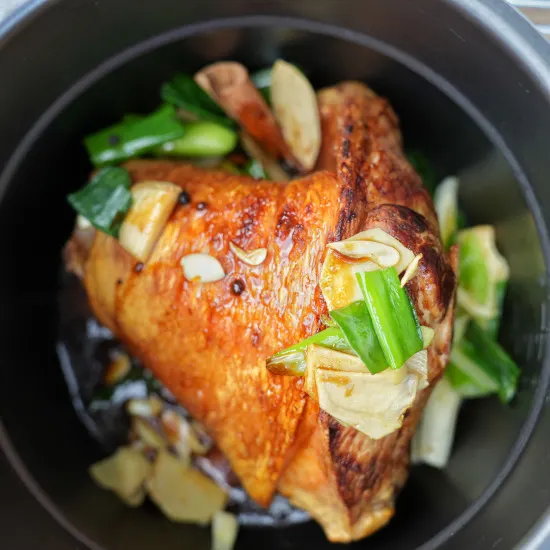
Slow cook the pork hock
- In a wok or large pan, heat some oil until hot. Saute the sliced scallions, ginger, and garlic cloves over medium heat until aromatic. Then, transfer the mixture to the slow cooker.
- Next, add the dry spices (bay leaf, cinnamon stick, and star anise) and the pork hock into the slow cooker.
- Add the seasonings listed in the ingredients, including light soy sauce, Shaoxing wine, sugar, and salt. Add water halfway to the pork hock.
- Set the slow cooker to high and let it cooks for an hour. After an hour, reduce the heat to low and continue cooking the pork hock. Turn the pork occasionally to ensure even cooking.
- Check the doneness of the pork hock, and stop cooking once it is soft and tender. Scoop out the pork hock and transfer it to a serving bowl.
- Pour the cooking juices through a wire mesh strainer to catch all the solids.
- Transfer the clean liquid into a pot and reduce it until it becomes a thick sauce.
- Pour the thick sauce over the pork hock to serve.
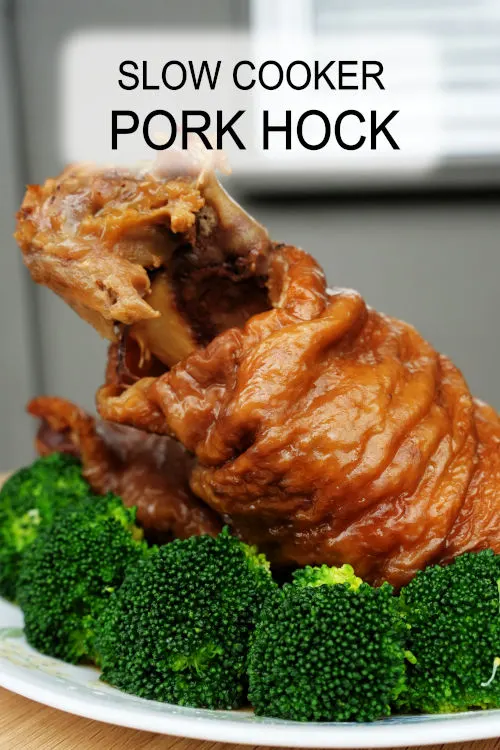
Cook’s note
- You can find pork hocks at your local butcher or in the meat section of the major supermarket.
- You can cook the pork hock over low heat in a large pot instead of using a slow cooker. The same cooking process applies, but the latter is more convenient.
- The pork hock is best served with some side vegetables. My favorite is broccoli florets.
The difference between pork knuckle, pork trotter, ham hock, and pork shank.
Pork hocks are also known as pork knuckles or pork trotters. It is the lower part of the pig’s front or hind leg, just above the ankle joint. They are usually sold with the skin on, and this skin can be cooked until it becomes crispy in the oven. In addition, it contains a lot of connective tissue, making it ideal for slow cooking or braising.
Ham hocks are the same cut as pork hocks but have been cured and smoked.
The pork shank is the lower part of the hind leg, just below the knee joint. Pork shanks are leaner than pork hocks, meaning they can be slightly less juicy but have a more intense pork flavor.
What is the difference between a crock pot, slow cooker, and instant pot?
A crock pot and a slow cooker are the same appliances. It is used to slow-cook any food. The best part is that the liquid will not dry out easily, and you can leave it unattended during cooking. These terms are often used interchangeably.
An instant pot is a type of multi-cooker which do pressure cooking, sautéing, and steaming. It can cook food much faster by using pressure. Instant pots generally have digital controls and provide a broader range of cooking options than traditional slow cookers.
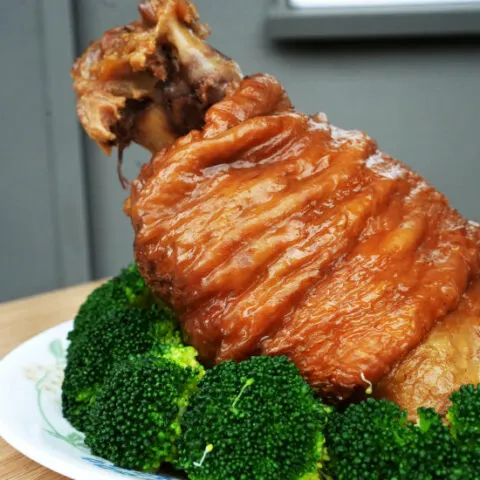
Slow cooker pork hock
Looking for a delicious and hearty meal? Try this slow cooker pork hock recipe with traditional Chinese flavors and perfectly cooked.
Ingredients
Ingredients A (blanch and bake the pork hock)
- 1 pork hock (1.3kg)
- 5 slices ginger
- 2 stalks of scallions, cut into 3-inch sections
- 1 tbsp rice wine
- 1 tbsp dark soy sauce
Ingredients B (saute until aromatic)
- 5 slices ginger
- 2 stalks of spring onions, cut into 3-inch sections
- 5 cloves garlic
Ingredients C (dry spices)
- 2 bay leaves
- 1/2 tsp black peppercorns
- 1 cinnamon stick
- 1 star anise
Ingredients D (seasonings)
- 1 tbsp Hoisin sauce
- 2 tbsp light soy sauce
- 1 tbsp oyster sauce
- 2 tbsp rice wine
- 1 tbsp sugar
- 1 teaspoon sesame oil
- 4 tablespoons Shaoxing wine
- Water to slow-cook the pork
Instructions
Blanch the pork
- Cleaning the pork hock and remove any hairs on the skin,
- Cook the pork with other ingredients in A for ten minutes. Be sure to turn it over at least once for even cooking.
- Remove the pork hock and drain away the water.
- Keep in the refrigerator overnight.
Roast to create blisters on the skin
- First, remove the pork from the refrigerator.
- Next, preheat the oven to 245°C/475°F.
- Combine the white vinegar and baking soda (Ingredients E), then apply it to the skin surface.
- Place the pork skin on the middle rack with the skin side exposed.
- Roast the pork hock for 30-40 minutes or until the skin blistered.
Slow-cook the pork
- Saute Ingredients B over medium heat until aromatic. Then, transfer the mixture to the slow cooker.
- Next, add Ingredients C, D, and the pork hock into the slow cooker.
- Set the slow cooker to high and let it cooks for an hour. After an hour, reduce the heat to low and continue cooking the pork hock. Turn the pork occasionally to ensure even cooking.
- Scoop out the pork hock and transfer it to a serving bowl.
- Pour the cooking juices through a wire mesh strainer to catch all the solids. Cook down the liquid until it becomes a thick sauce.
- Pour the thick sauce over the pork hock to serve.
Recommended Products
As an Amazon Associate and member of other affiliate programs, I earn from qualifying purchases.
-
 McCormick Cinnamon Sticks, 0.75 oz
McCormick Cinnamon Sticks, 0.75 oz -
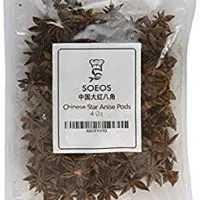 Soeos Star Anise Seeds (Anis Estrella), Whole Chinese Star Anise Pods, Dried Anise Star Spice, 4 oz.
Soeos Star Anise Seeds (Anis Estrella), Whole Chinese Star Anise Pods, Dried Anise Star Spice, 4 oz. -
 Lee Kum Kee Hoisin Sauce, 20 oz
Lee Kum Kee Hoisin Sauce, 20 oz -
 Instant Pot DUO60 6 Qt 7-in-1 Multi-Use Programmable Pressure Cooker, Slow Cooker, Rice Cooker, Steamer, Sauté, Yogurt Maker and Warmer
Instant Pot DUO60 6 Qt 7-in-1 Multi-Use Programmable Pressure Cooker, Slow Cooker, Rice Cooker, Steamer, Sauté, Yogurt Maker and Warmer
Nutrition Information:
Yield: 4 Serving Size: 1Amount Per Serving: Calories: 278Total Fat: 8gSaturated Fat: 3gTrans Fat: 0gUnsaturated Fat: 5gCholesterol: 38mgSodium: 998mgCarbohydrates: 32gFiber: 3gSugar: 7gProtein: 15g
This data was provided and calculated by Nutritionix on 5/5/2023

Britt
Sunday 9th of July 2023
My pork hock still has the trotter attached. Could I do this recipe with the whole piece?
KP Kwan
Sunday 9th of July 2023
Yes. You can cut it into half if it is too large to fit into the pot.
KP Kwan
Saturday 6th of May 2023
Hi, this is KP Kwan. I am happy to see you in this comment area, as you have read through my recipe. I am glad to reply to any questions and comments as soon as possible.